Rating the Best Slim AV Receivers 2024 The Compact Champions Space-saving audio excellence in 2023: Discover our review of the best small AV receivers for compact setups and efficient audio solutions. 12/20/202312/19/2023by Eddie Campbell Name Channels Power output HDMI in/out Bluetooth/Wi-Fi Review Marantz NR1510 best overall 5.2 50W/8 Ohm, 60W/6 Ohm 6/1 yes/yes Review Marantz Cinema 70S 7 channels 7.2 50W/8 Ohm, 70W/6 Ohm 6/3 yes/yes Review Sony STRDH590 compact 5.2 145W/6 Ohm 4/1 yes/no Review Pioneer VSX-534 5.2 80W/8 Ohm, 150W/6 Ohm 4/1 yes/no Review How does a slim AV receiver differ from a regular one?

Space-saving audio excellence in 2023: Discover our review of the best small AV receivers for compact setups and efficient audio solutions. 12/20/202312/19/2023by Eddie Campbell
| Name | Channels | Power output | HDMI in/out | Bluetooth/Wi-Fi | Review |
|---|---|---|---|---|---|
| Marantz NR1510 best overall | 5.2 | 50W/8 Ohm, 60W/6 Ohm | 6/1 | yes/yes | Review |
| Marantz Cinema 70S 7 channels | 7.2 | 50W/8 Ohm, 70W/6 Ohm | 6/3 | yes/yes | Review |
| Sony STRDH590 compact | 5.2 | 145W/6 Ohm | 4/1 | yes/no | Review |
| Pioneer VSX-534 | 5.2 | 80W/8 Ohm, 150W/6 Ohm | 4/1 | yes/no | Review |
How does a slim AV receiver differ from a regular one?
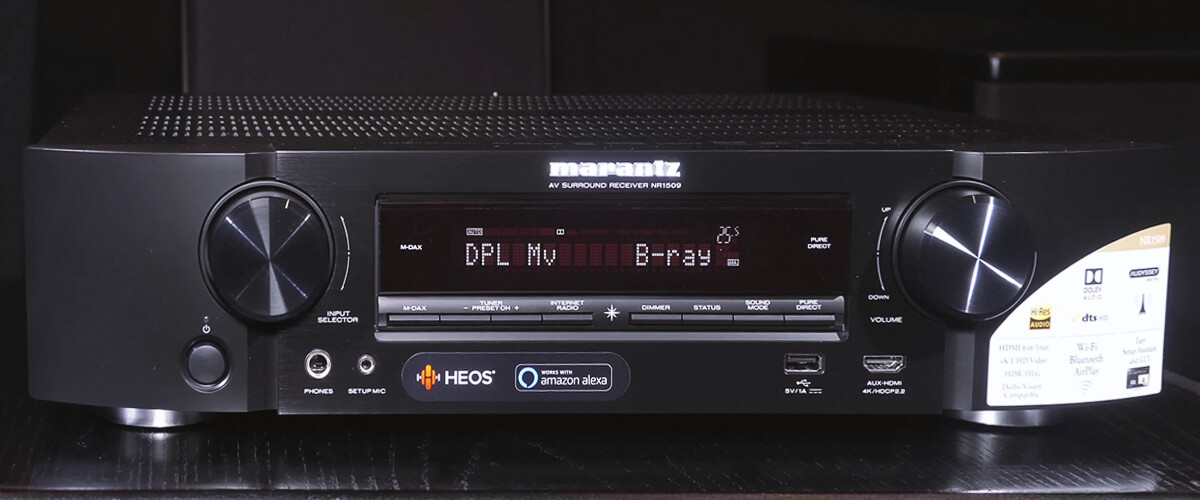
Low-profile AV receivers basically retain the quality of internal components and functionality of the device. However, 3 main aspects must be considered before purchasing such a device:
- Size is an advantage of a narrow receiver regarding the convenience of system placement, but it affects the location of internal electrical components. Logically, their closer proximity to each other implies an increased possibility of distortion and interference during playback.
- For this reason, mini AV receivers usually have lower power and higher THD, which can affect the overall soundstage. They also usually have fewer channels and connections. This is why I insist that the narrow profile is for smaller living rooms.
- If you come across a more or less similar slim and standard receiver, the former is likely to be cheaper. This can also be seen as an advantage if your budget is limited, but let’s be frank – price matters. We can conclude that receivers with a reduced size will suit those who want a modest home theater in all parameters (number of channels, power, and price).
Best slim AV receiver reviews
Jump to- Marantz NR1510 – best overall.
- Marantz Cinema 70S – 7 channels.
- Sony STRDH590 – compact.
- Pioneer VSX-534.
Marantz NR1510 – best overall
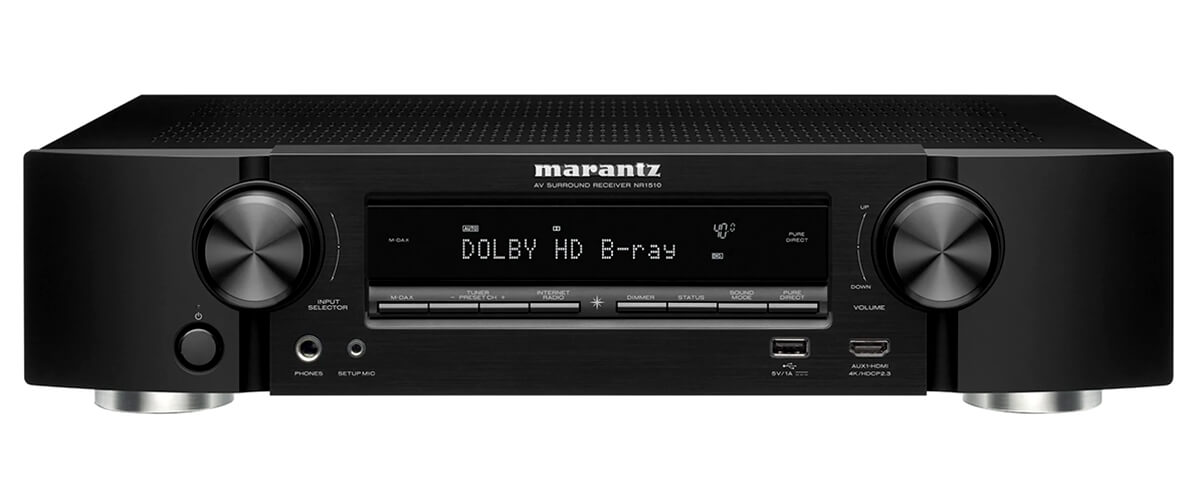
Drum roll… Fireworks! Meet the winner of my rating, which (as it often happens in my reviews) has the main advantage over other models, namely the optimal price/quality ratio. The Marantz NR1510 is a 5.2-channel receiver with dimensions of 17.4″ x 4.3″ x 15″ and a weight of 18 lbs.
Its power output is minimal at 50W (8 Ohms, 20Hz – 20kHz, 0.08%, 2ch Drive), but it’s not the only low-power representative of my selection. However, it is worth noting that the distortion index compensates for the lack of power with the purity of sound at the highest volume. The brand never sacrifices the quality of sound reproduction, finding compromises that condition the low price in other areas.
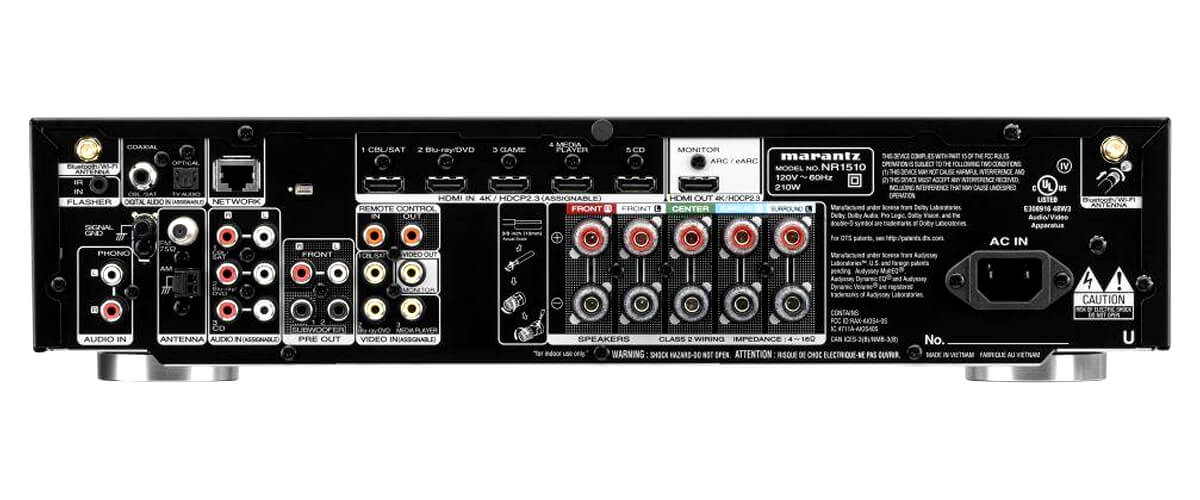
Since it’s not new to the Marantz lineup, the receiver was released in 2019, providing video broadcasting at 4K/60Hz resolution. But it has many HDMI ports (and further in the review, you’ll see that for a 5-channel AVR, it’s quite a lot), and they all work very well (6 inputs and 1 output). Often, in such models, you can find a delay when switching the source or desynchronization of the signal. But the NR1510 does well in this area.
You’ll be able to view content with DTS-HD Master Audio soundtracks in the original, thanks to the HDMI eARC feature. The receiver doesn’t decode the other formats, but you’ll hear them differently than the director intended. Believe me, in a system like this, you won’t know what I’m talking about. The receiver sounds great for its rank. And I highlighted very clear dialog.
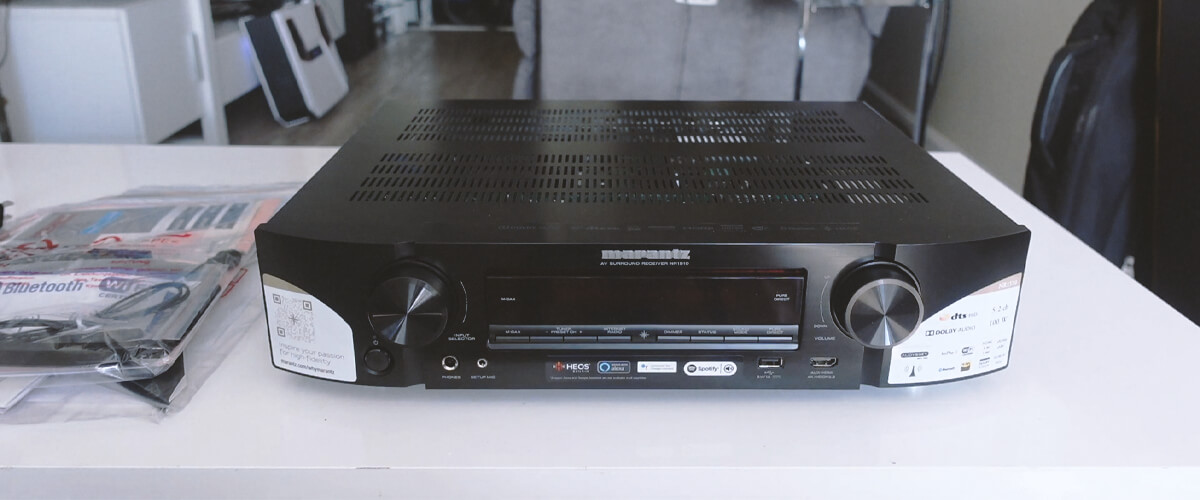
Even though I was somewhat, so to say, unimpressed with Bluetooth (I noticed some minor delays in playback), the NR1510 is otherwise a pretty advanced device. It’s got Wi-Fi, AirPlay 2, TuneIn, and a built-in HEOS multicomputer broadcaster. So, it supports some of the most popular streaming services. The M-DAX technology improves the quality of compressed audio (like MP3s), and I even noticed that my old speakers sound brighter.
Marantz NR1510 is the best small AV receiver of my selection. It is value for money, sounds great with surround sound, and can enhance compressed audio. The versatile, really very narrow receiver can give a small living room an atmosphere of coziness and comfort.
Key specs
-
Channels: 5.2.
-
Power output: 50W/8 Ohm, 60W/6 Ohm.
-
HDMI inputs/outputs: 6/1.
-
Video functions: 4K/60Hz.
-
Bluetooth/Wi-Fi: yes/yes.
-
Streaming services: AirPlay 2, Spotify, TuneIn, Deezer, Tidal, Netflix, Amazon Prime.
-
Supports: HDMI ARC, HDMI eARC, HDMI CEC, HDCP2.3, HDR10, Dolby Vision.
-
Surround sound: DTS HD Master, Audyssey.
-
Channels: 5.2.
-
Power output: 50W/8 Ohm, 60W/6 Ohm.
-
HDMI inputs/outputs: 6/1.
-
Video functions: 4K/60Hz.
-
Bluetooth/Wi-Fi: yes/yes.
-
Streaming services: AirPlay 2, Spotify, TuneIn, Deezer, Tidal, Netflix, Amazon Prime.
-
Supports: HDMI ARC, HDMI eARC, HDMI CEC, HDCP2.3, HDR10, Dolby Vision.
-
Surround sound: DTS HD Master, Audyssey.
Pros
- Optimal price/quality ratio of the whole rating.
- A large number of HDMI ports (6/1) for a 5-channel receiver.
- Good surround sound, with clear dialogs.
- M-DAX function can improve the sound of old speakers and the quality of compressed audio.
Cons
-
Supports only one surround sound format, DTS-HD Master Audio.
-
Bluetooth sometimes works with minor delays.
-
Optimal price/quality ratio of the whole rating.
-
A large number of HDMI ports (6/1) for a 5-channel receiver.
-
Good surround sound, with clear dialogs.
-
M-DAX function can improve the sound of old speakers and the quality of compressed audio.
-
Supports only one surround sound format, DTS-HD Master Audio.
-
Bluetooth sometimes works with minor delays.
Check price on AmazonView at Walmart
Marantz Cinema 70S – 7 channels
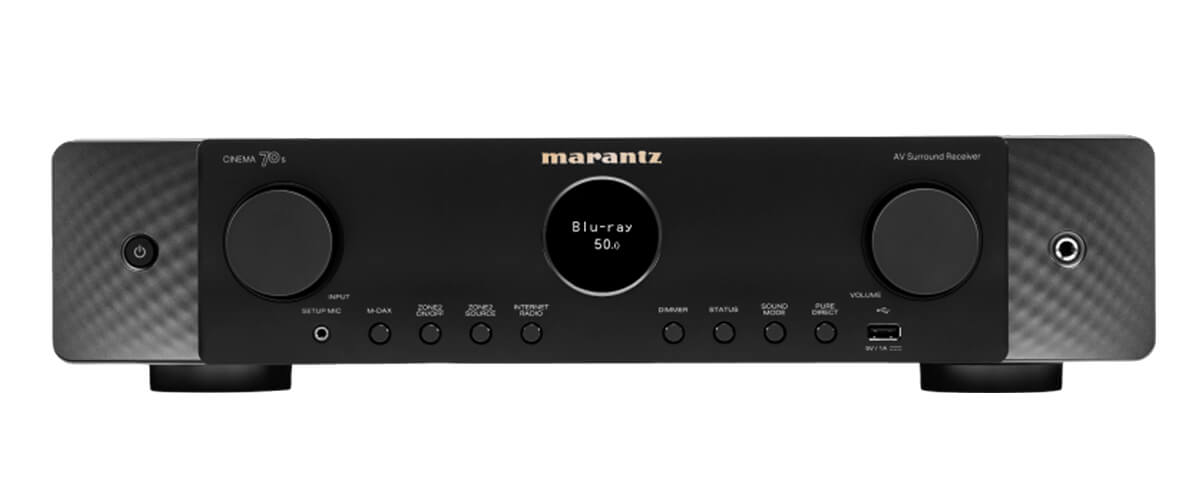
In second place is again the smallest AV receiver from Marantz and also the newest (year of release 2022). The dimensions of the Marantz Cinema 70S are identical to those of the selection leader. Still, its weight is slightly higher (19.2 lbs), which indicates that some circuitry used inside the case is obviously better quality than the NR1510. Though the differences are mostly about functionality, as in power delivery, the receivers are also the same (50W (8 Ohms, 20Hz – 20kHz, 0.08%, 2ch), which is quite strange when we are talking about different numbers of channels.
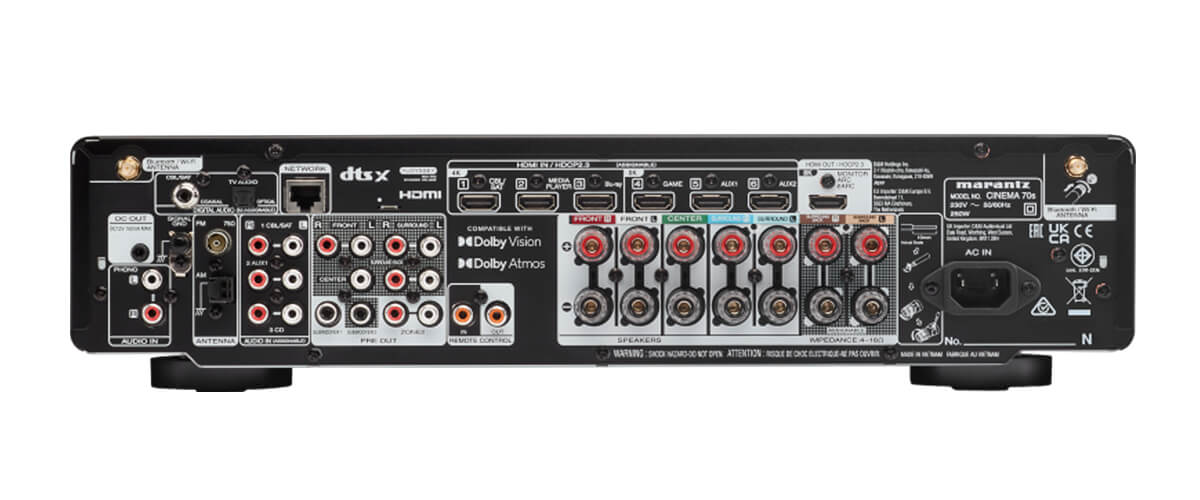
In this case, we are facing a 7.2-channel receiver with 8K resolution video processing and upscaling (the only one on the list). 3 of its 6/1 HDMI ports are version 2.1. And so you can use the receiver to watch movies of any quality from any source (be it a streaming site or BluRay disc) and play games on consoles (all the necessary functionality is available). Not without reason in its name, there is the word “Cinema”. Today, it meets all the parameters and will not need to be upgraded.
Cinema 70S is also great for listening to music in high-quality stereo from a digital source or vinyl. Its wireless capabilities are also similar to the NR1510 options, but I liked the level of digital signal transmission better (not surprisingly, the receiver is almost twice as expensive as the chart leader). It is, by the way, perfectly compatible with any Apple equipment; it is even stated in the specification. This model also sounds more authentic with vinyl. Such a warm, smooth, clear, and at the same time rich sound. I generally think the model outperforms most competitors in its category, especially considering the narrow design. Bravo, Marantz!
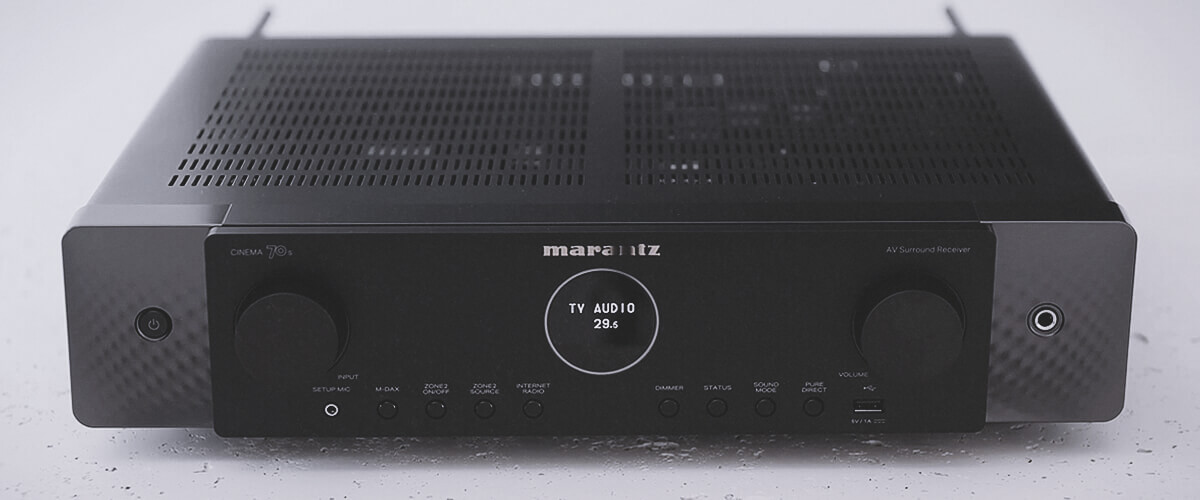
As for surround sound, if we’re talking about Cinema, the 7-channel system implies a 5.1.2 configuration, which means you can enjoy the most popular today immersive Dolby Atmos and DTS:X formats. But I dare to remind you that the AVR has a small output, and having tried it in different rooms, I concluded that a 250 square-foot room is the maximum possible. In this case, the sound is balanced and reaches every corner of the room with equal intensity and nuance. As for the calibration system, the model in question has a better calibration system than the NR1510. Audyssey MultEQ is more advanced and adaptive than its earlier versions, and therefore, it will be easy to handle even for a beginner. For the average viewer, the automatic settings will be enough.
The Marantz Cinema 70S may be quite expensive considering the pricing policy of my selection, but it will be a great investment. With a receiver like this, you won’t need to upgrade for years. It’s a modern device with plenty of features, although it’s designed to be installed in smaller rooms. The warm, rich sound will definitely not leave you indifferent.
Key specs
-
Channels: 7.2.
-
Power output: 50W/8 Ohm, 70W/6 Ohm.
-
HDMI inputs/outputs: 6/3.
-
Video functions: 8K/60Hz, 4K/120Hz, 4K/60Hz pass-through, 1080p to 8K/4K video upscaling via HDM.
-
Bluetooth/Wi-Fi: yes/yes.
-
Streaming services: AirPlay2, Deezer, Tidal, Pandora, Spotify, Amazon Music HD, TuneIn.
-
Supports: HDMI ARC, HDMI eARC, HDMI CEC, HDCP2.3, HDR10, HDR10+, Dolby Vision.
-
Surround sound: DTS HD Master, DTS Neural:X, Dolby TrueHD, Dolby Surround, Dolby Digital Plus, Dolby Atmos Height Virtualization, Dolby Atmos.
-
Channels: 7.2.
-
Power output: 50W/8 Ohm, 70W/6 Ohm.
-
HDMI inputs/outputs: 6/3.
-
Video functions: 8K/60Hz, 4K/120Hz, 4K/60Hz pass-through, 1080p to 8K/4K video upscaling via HDM.
-
Bluetooth/Wi-Fi: yes/yes.
-
Streaming services: AirPlay2, Deezer, Tidal, Pandora, Spotify, Amazon Music HD, TuneIn.
-
Supports: HDMI ARC, HDMI eARC, HDMI CEC, HDCP2.3, HDR10, HDR10+, Dolby Vision.
-
Surround sound: DTS HD Master, DTS Neural:X, Dolby TrueHD, Dolby Surround, Dolby Digital Plus, Dolby Atmos Height Virtualization, Dolby Atmos.
Pros
- It’s the only 7.2-channel receiver in my rating.
- Modern video capabilities (8K video compatibility).
- Compatible with Apple devices.
- Sounds great in surround sound, stereo, and with vinyl.
- Audyssey MultEQ is incredibly simple and adapts the sound perfectly.
Cons
-
Low power for a 7-channel receiver.
-
It’s the only 7.2-channel receiver in my rating.
-
Modern video capabilities (8K video compatibility).
-
Compatible with Apple devices.
-
Sounds great in surround sound, stereo, and with vinyl.
-
Audyssey MultEQ is incredibly simple and adapts the sound perfectly.
-
Low power for a 7-channel receiver.
Check price on Amazon
Sony STRDH590 – compact
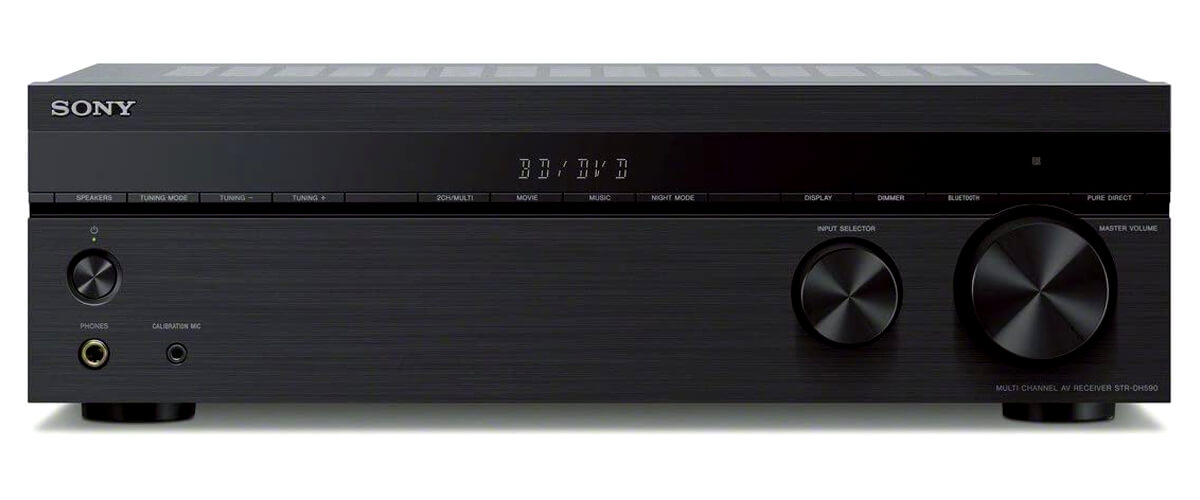
The next entrant in this “competition,” Sony STR-DH590, is a very inexpensive, compact 5.1 receiver. Its dimensions of 17″ x .3″ x 11.8″ are not so small compared to the dimensions of the reviewed Marantz models, and its weight is less, at 15 lbs. This, as you already know, is indicative of low-quality construction components. But it was clear when I looked at the price tag.
I’m not an ageist, but for tech, age matters. And a receiver released in 2018 will be inferior to newer models on all fronts. So comparing it to the Cinema 70S is out of the question. Although it is quite similar to the Marantz NR1510, for example, it provides 4K/60Hz video in the realm of video capabilities. But the STR-DH590 has fewer HDMI ports (4/1), just like the NR1510 – with basic functionality. Nevertheless, I should note that such a picture will suit the viewer quite well because most content today is released with this resolution.
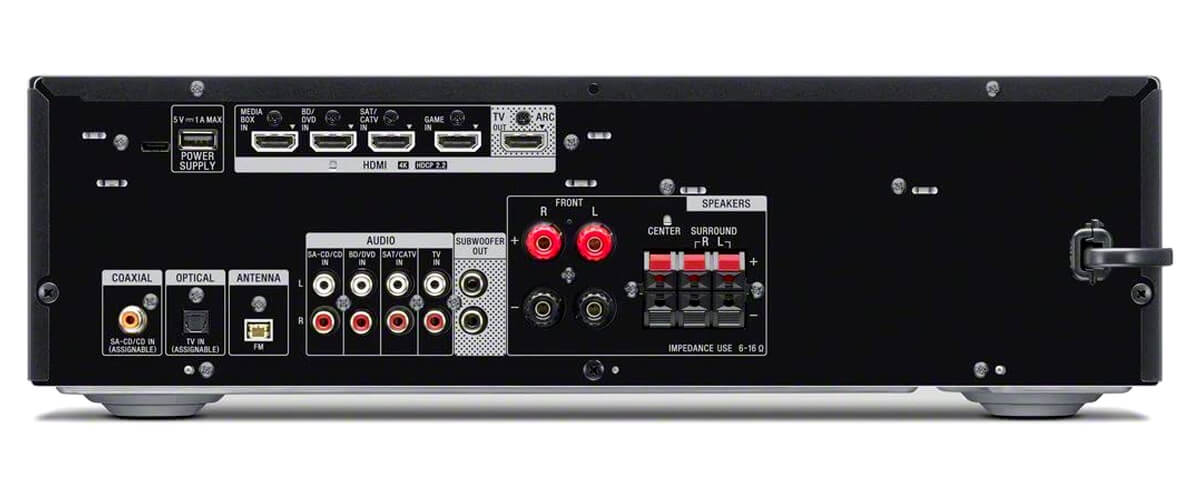
What favorably distinguishes the model under consideration from its predecessors is the power. It is 90 W (6 Ohms, 20 Hz – 20 kHz, 2 ch), which is quite a lot for a 5-channel receiver. That said, the STR-DH590 is compatible with a wide range of speakers from 6 to 16 ohms. And you can even connect 4 ohms to it, but keep an eye on the temperature because the unit overheats in this case. However, during prolonged use, I also noticed overheating, which is not strange for the price category of the receiver.
The wireless capabilities of the model are limited by the presence of Bluetooth. But it’s version 4.2. copes quite well with audio broadcasting. I listened to my playlists with Spotify, and I will say that almost all songs sounded pretty convincing. Sure, it doesn’t have the richness and bass you can hear with more expensive models, but the STR-DH590 does quite well as an amplifier. Sony’s slightly cool sound gives a certain charm to the music.
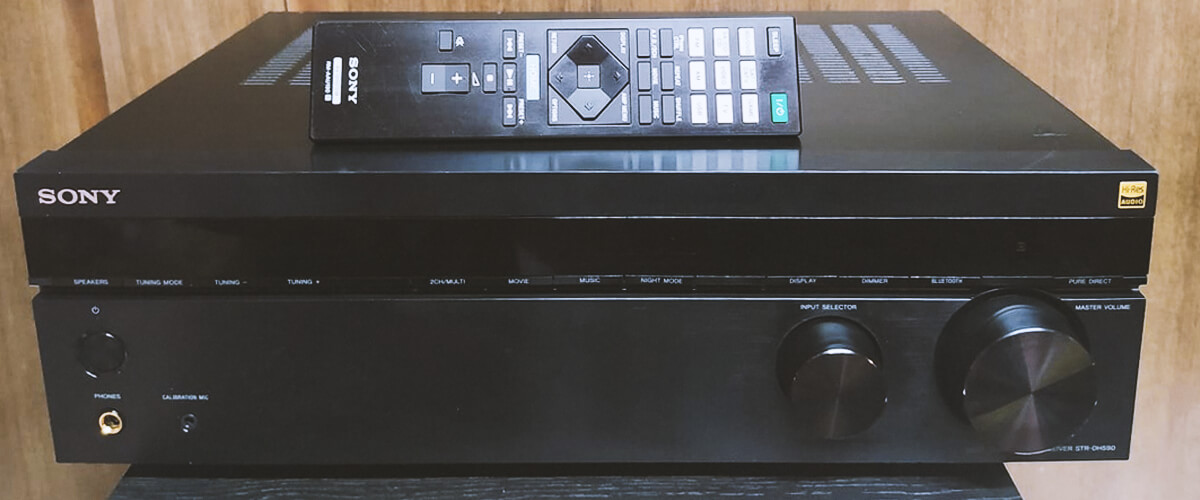
Surround sound is available in Dolby Digital and DTS-HD Master Audio formats, which is standard for 5-channel AVRs. But the S-Force PRO feature is worth mentioning here. It allows you to use only the front speakers to simulate surround sound. Let’s say it’s not a full immersion into the soundstage, but it’s still more interesting than stereo sound. Plus, it can save you from buying a full-fledged speaker system if you’re not ready due to finances.
Sony STR-DH590 is an excellent budget AV receiver with a relatively narrow design. It handles surround sound formats and stereo sound decently enough for you to consider it a good assistant in your leisure time.
Key specs
-
Channels: 5.2
-
Power output: 145W/6 Ohm.
-
HDMI inputs/outputs: 4/1.
-
Video functions: 4K/60Hz pass-through.
-
Bluetooth/Wi-Fi: yes/no.
-
Streaming services: has not.
-
Supports: HDMI ARC, HDCP 2.2, HDR10, Dolby Vision.
-
Surround sound: DSD, DTS HD Master, Dolby Digital, Dolby Dual Mono.
-
Channels: 5.2
-
Power output: 145W/6 Ohm.
-
HDMI inputs/outputs: 4/1.
-
Video functions: 4K/60Hz pass-through.
-
Bluetooth/Wi-Fi: yes/no.
-
Streaming services: has not.
-
Supports: HDMI ARC, HDCP 2.2, HDR10, Dolby Vision.
-
Surround sound: DSD, DTS HD Master, Dolby Digital, Dolby Dual Mono.
Pros
- It works with a wide range of speakers from 6 to 16 Ohms.
- S-Force PRO feature that simulates surround sound using only the front speakers.
Cons
-
Low weight indicates the use of low-quality internal components.
-
Overheats with prolonged use and with low-impedance speakers.
-
No Wi-Fi.
-
It works with a wide range of speakers from 6 to 16 Ohms.
-
S-Force PRO feature that simulates surround sound using only the front speakers.
-
Low weight indicates the use of low-quality internal components.
-
Overheats with prolonged use and with low-impedance speakers.
-
No Wi-Fi.
Check price on AmazonView at Walmart
Pioneer VSX-534
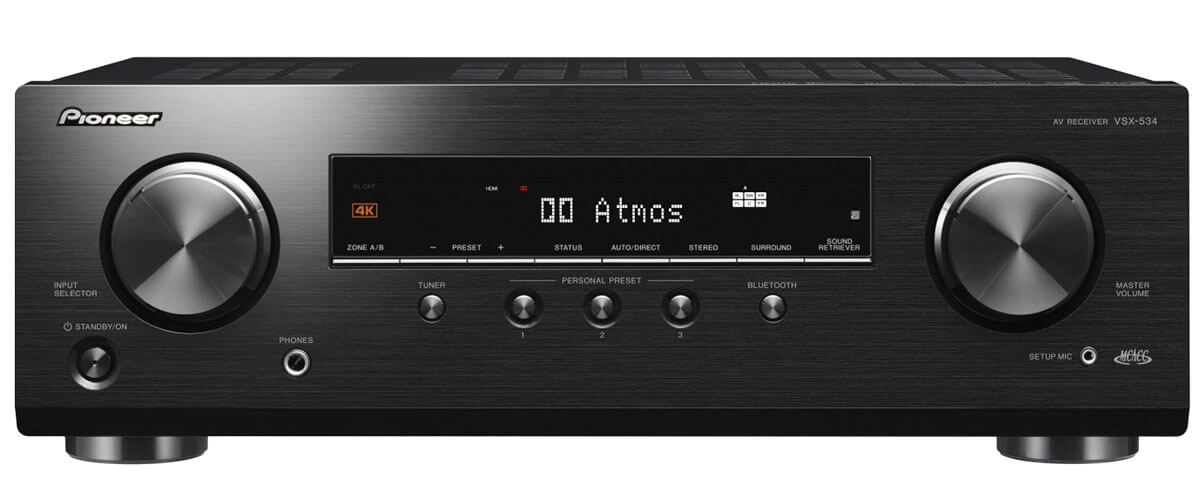
The latest in my list, Pioneer VSX-534, may be far from the smallest surround sound receiver. But it does have reduced dimensions relative to standard AVRs (17.2″ x 5.8″ x 12.6″ and weighs 17.6) and can decode Dolby Atmos and DTS:X surround sound formats unique to a 5.1 system.
Yes, you didn’t make a mistake when you read that. And I wasn’t wrong when I wrote it. Pioneer has developed the only receiver that, in a 3.2.1 configuration, broadcasts the soundtrack of the most popular and available with only 7 channels of immersive formats. But let’s be honest. Of course, the sound of your home theater with the VSX-534 as the centerpiece can’t compare to even the simplest 7.1-channel receiver in terms of soundtrack distribution. It’s just not possible. And yet, by attaching two speakers to the ceiling, you can create overhead channels, depriving yourself of a couple of floorstanders. Using wireless headphones, you can listen to audio in the second zone. Cool for such a small device.
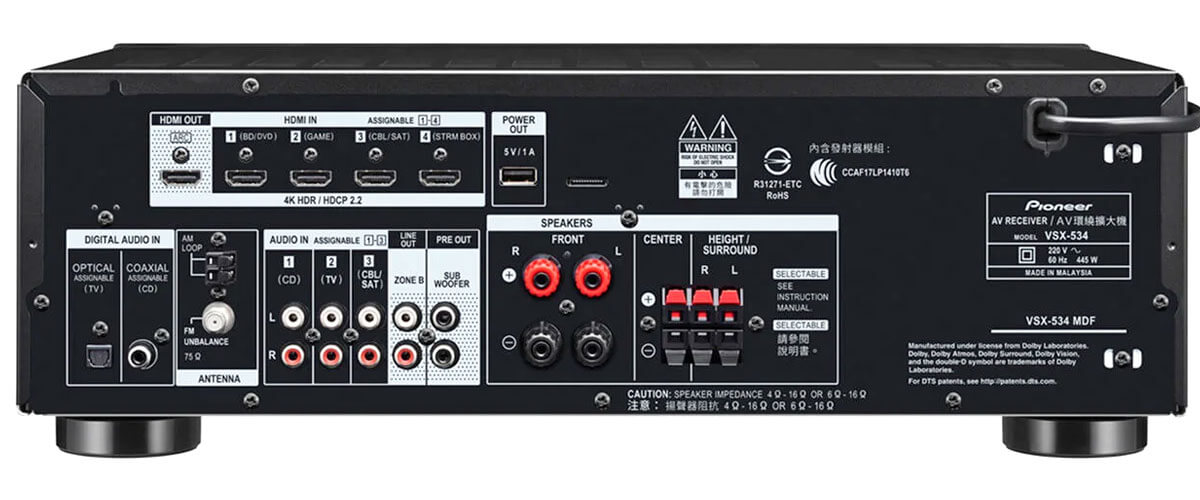
As I started with sound, it’s worth noting that the VSX-534 is the most powerful receiver on my list. Its rating is 80W (8 Ohms, 20Hz-20kHz, 2 ch), but you should pay attention to the THD of 0.8%. Such a figure indicates that the sound will have interference at maximum volume. So, in practice, we are dealing with a still underpowered compact receiver.
This budget AVR is the same as the Sony STR-DH590 or Marantz NR1510 regarding video functions. The model was released in 2019, so it skips 4K video, but unlike its competitors, it can also enhance lower-resolution video to that level.
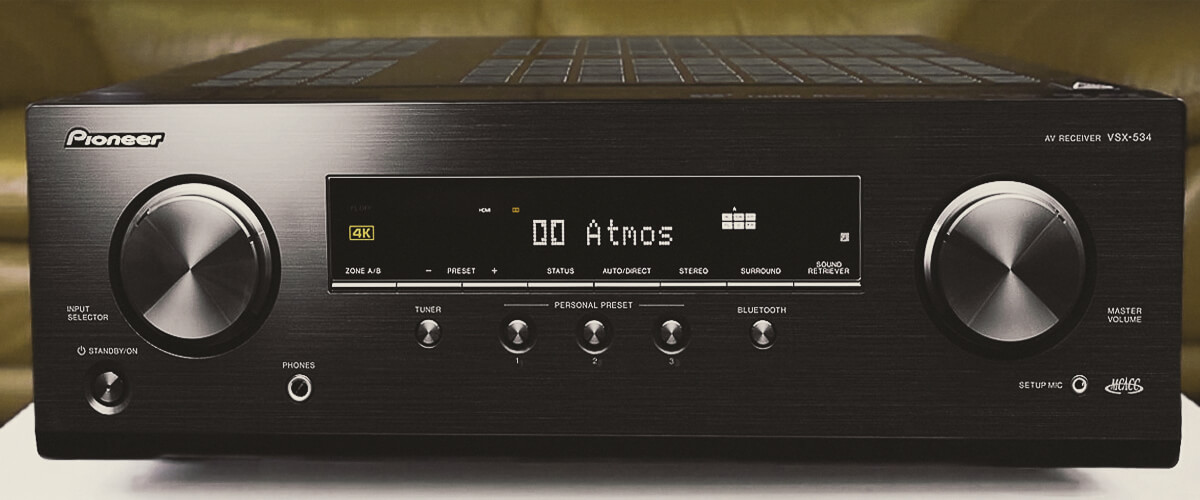
Of the additional features, there is Bluetooth 4.2 with support for SBC and AAC codecs and the MCACC calibration system, considered one of the most primitive. But it’s not for nothing that I listed it as an “extra” option because, in the case of the VSX-534 model, you can save 3 customization options, so you don’t have to go back and customize the system every new time.
Pioneer VSX-534 – a great option for those who do not have the financial ability but still want to learn the world of surround sound Dolby Atmos. Its sound is even, without frills, but decent and fills a small room well because the reduced size did not greatly affect the power reduction. “Budget doesn’t mean with limitations,” says Pioneer, and we believe it.
Key specs
-
Channels: 5.2.
-
Power output: 80W/8 Ohm, 150W/6 Ohm.
-
HDMI inputs/outputs: 4/1.
-
Video functions: 4K/60Hz pass-through, upscales HD video signals to 4K Ultra HD.
-
Bluetooth/Wi-Fi: yes/no.
-
Streaming services: no.
-
Suppots: HDMI ARC, HDMI eARC, HDMI CEC, HDMI Upscaling, HDMI HDR, HDMI HGL.
-
Surround sound: Dolby Atmos, DTS:X, DTS Neural:X, DTS Virtual:X, DTS HD Master, Dolby TrueHD, Dolby Digital Plus, Dolby Atmos Height Virtualizer.
-
Channels: 5.2.
-
Power output: 80W/8 Ohm, 150W/6 Ohm.
-
HDMI inputs/outputs: 4/1.
-
Video functions: 4K/60Hz pass-through, upscales HD video signals to 4K Ultra HD.
-
Bluetooth/Wi-Fi: yes/no.
-
Streaming services: no.
-
Suppots: HDMI ARC, HDMI eARC, HDMI CEC, HDMI Upscaling, HDMI HDR, HDMI HGL.
-
Surround sound: Dolby Atmos, DTS:X, DTS Neural:X, DTS Virtual:X, DTS HD Master, Dolby TrueHD, Dolby Digital Plus, Dolby Atmos Height Virtualizer.
Pros
- The 5-channel receiver supports Dolby Atmos and DTS:X surround sound formats in a 3.1.2 configuration.
- The most powerful in the rating.
- It has the function of upscaling to 4K, unlike other 5-channel receivers on my list.
- The Personal Preset feature allows you to save three calibration options.
- With wireless headphones, you can listen to sound in a different zone.
Cons
-
Configuration 3.1.2 does not fully display the Dolby Atmos soundscape.
-
THD is higher than other models, and the receiver has interference at high volume.
-
No Wi-Fi.
-
The 5-channel receiver supports Dolby Atmos and DTS:X surround sound formats in a 3.1.2 configuration.
-
The most powerful in the rating.
-
It has the function of upscaling to 4K, unlike other 5-channel receivers on my list.
-
The Personal Preset feature allows you to save three calibration options.
-
With wireless headphones, you can listen to sound in a different zone.
-
Configuration 3.1.2 does not fully display the Dolby Atmos soundscape.
-
THD is higher than other models, and the receiver has interference at high volume.
-
No Wi-Fi.
Check price on Amazon
FAQ
Does the reduced size of a slim AV receiver impact its audio quality?
The reduced size of a slim AV receiver does not necessarily impact its audio quality. Usually, they are as good as standard ones regarding the internal components’ quality. However, it should be remembered that the placement of circuitry in a slim profile implies their close proximity, which increases the risk of interference. Therefore, narrow profile receivers are often less powerful and have a higher distortion factor, which affects the overall sound picture of the system using AVR of this type.
Can slim AV receivers power high-end speaker systems effectively?
Of course, slim AV receivers power high-end speaker systems effectively, although they are often less powerful than full-size ones. It’s not about the size of the receiver at all but about its compatibility with the speaker system. That is, you need to check the power rating and impedance on the AVR and the speakers, and if they are in the same range, feel free to connect the system. Otherwise, the speakers may be damaged over time. - Privacy
- Affiliate policy
- Contact us
FAQ
What is AV in cinema?
An audiovisual work (AV work) is a series of related images that are capable of being shown by some device, along with any sounds that accompany the visual portion of the work. The audiovisual works category includes movies and films, as well as slide shows, video games, and the like.
What is the best AV receiver brand?
An audiovisual work (AV work) is a series of related images that are capable of being shown by some device, along with any sounds that accompany the visual portion of the work. The audiovisual works category includes movies and films, as well as slide shows, video games, and the like.
What is AV in amplifier?
(Audio/Video receiver) A combination audio amplifier and audio/video switching device for a home theater. An A/V receiver contains inputs for all the user’s audio and video sources such as a cable TV box, Blu-ray or CD player and digital media hub (Apple TV, Roku, etc.).
What is the best AV receiver brand?
With 4K, the entire chain needs to be 4K compatible. So if you buy a new 4K TV, want to feed it 4K via HDMI sources, and want to switch those sources using an AV receiver (as opposed to the TV), you’ll need to buy a new receiver that handles those 4K sources.17 Apr 2024
What is the meaning of AV receiver?
(Audio/Video receiver) A combination audio amplifier and audio/video switching device for a home theater. An A/V receiver contains inputs for all the user’s audio and video sources such as a cable TV box, Blu-ray or CD player and digital media hub (Apple TV, Roku, etc.).




















 HDMI Cable
HDMI Cable Cables
Cables Turntables
Turntables Demo ClearanceDiscover a meticulously curated selection of the finest audio brands, each chosen with care to ensure an unparalleled listening experience. Our collection features some of the most respected names in the industry, including Focal, Magico, Aurender, Bayz A
We do not share or sell your information.
Demo ClearanceDiscover a meticulously curated selection of the finest audio brands, each chosen with care to ensure an unparalleled listening experience. Our collection features some of the most respected names in the industry, including Focal, Magico, Aurender, Bayz A
We do not share or sell your information.